It’s hard to tell a lot from the small pictures, but this appears to be a project. Note how far forward the radiator is positioned. I hope that’s not where it attaches.
“51 willys jeep 350 4 bolt main 350 trans new motor new rims and tires”
It’s hard to tell a lot from the small pictures, but this appears to be a project. Note how far forward the radiator is positioned. I hope that’s not where it attaches.
“51 willys jeep 350 4 bolt main 350 trans new motor new rims and tires”
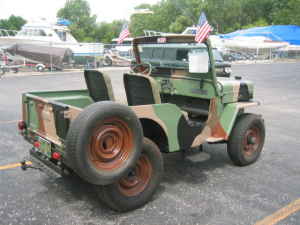 UPDATE: Price dropped to $9,000
UPDATE: Price dropped to $9,000
oh hold the phone .. the body is fiberglass? CJ-3B? That’s pretty rare!
“1953 Willys Jeep CJ3B, VIN: 4J15049, Engine: 4 cylinder, Trans: 3 speed with transfer case in and out 4×4, This vehicle has over 700 hours invested into it. The tub is fiberglass but the hood, fenders, frame, drivetrain are all original to the vehicle. Runs and drives great. Still has original 6 volt system, guages, shifters, shift pattern information plates, etc. A definate must see. We are accepting offers. We have turned down $7,500 so no low ball offers please. Any questions call us at 262-639-5278 or 664-3032 or 880-5278. Ask for Chris or Ron.
 Sebastian, whom I mentioned in this post (a couple posts down), taught me a couple things about Willys in Colombia today.
Sebastian, whom I mentioned in this post (a couple posts down), taught me a couple things about Willys in Colombia today.
1) Willys are very popular in Colombia. They started arriving during the 50’s and immediately became a sensation. They are still used regularly in the coffee plantations. He assures us that every single coffee beam that we enjoy in a Colombian Coffee has been transported at some point in a Willys (most probably a CJ-3B). There are cities and towns where you can see Willys everywhere, being used as work vehicles. For somebody from this country it would be like going back on time. They are also used as taxis, carrying people by the dozen. [Editor’s note: Nice work Sebastian; I am sold on a trip to Colombia :-)]
 2) There are many Jeep festivals in Colombia. Most of them occur between September and October; they are called “Yipaos”. The festivals were started in 1988. The vehicles are driven through the main streets of a city and the Jeeps with the largest amount of objects carried with the most harmonious arrangements earn prizes. In fact, in February 2006, a Guinness World Records was established for the “Longest Jeep Parade” in Calarca, with a caravan of over 370 Jeep Willys vehicles. It seem to me that we need to break that record back! Here’s an article about it on the CJ-3B page.
2) There are many Jeep festivals in Colombia. Most of them occur between September and October; they are called “Yipaos”. The festivals were started in 1988. The vehicles are driven through the main streets of a city and the Jeeps with the largest amount of objects carried with the most harmonious arrangements earn prizes. In fact, in February 2006, a Guinness World Records was established for the “Longest Jeep Parade” in Calarca, with a caravan of over 370 Jeep Willys vehicles. It seem to me that we need to break that record back! Here’s an article about it on the CJ-3B page.
Sebastian also sent me a powerpoint with some nice big pictures of one festival. You just gotta see it to believe. Check out the mud flaps … I’ve been looking for some older looking mud flaps!
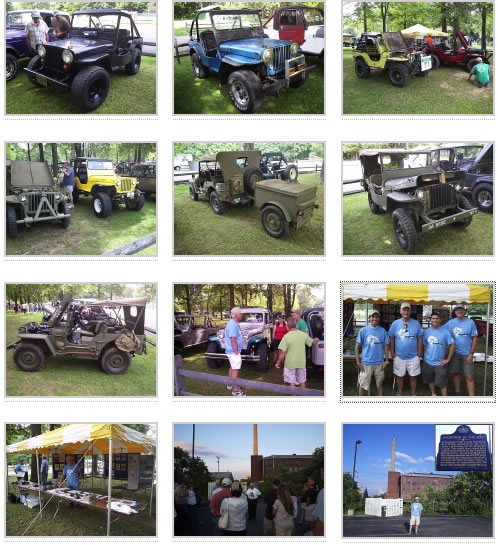 As I mention in the post below, Sebastian wrote me yesterday and told me a little about the Flat Fender Club of Butler. As I understand it, Sebastian launched the club website last year. It sounds like it’s kind of an ‘open source’ club.
As I mention in the post below, Sebastian wrote me yesterday and told me a little about the Flat Fender Club of Butler. As I understand it, Sebastian launched the club website last year. It sounds like it’s kind of an ‘open source’ club.
Sebastian writes, “The Flat Fender Club of Butler is a very nice group. I am doing my best to help out. A friend of mine from Colombia helped me with the logo and the t-shirt design and I started the blog at the beginning of the summer. The club is very informal, with no dues and no officers, only the president and founder Dave Zibrat (great guy!). Butler is the place where the “Bantam” factory was located (the building is still there), and therefore it is the place where everything related to Jeep started.”
It appears several of the club members are readers of ewillys and I look forward interacting with more.

In 1994, Sebastian and his father (who owns a blue CJ-3A), rebuilt a red 1954 CJ-3B, which can be seen to the right and viewed at the CJ-3B Page (sixth down from the top).
He writes, “My Willys is still in Colombia, so I only ride a couple times a year. Last May I went there for a week and put more than 250 miles on the jeep in less than five days. A couple years ago I became aware, and joined, the “Flat Fender Club of Butler” which is close to Pittsburgh. Butler is the place where the “Bantam” factory was located (the building is still there) and, therefore, it is the place where everything related to the Jeep started. The club is formed by a very nice group of people who are crazy about old willys. You can see some of the recent events and history of the club at: http://flatfenderclubofbutler.wordpress.com/ This blog also shows some pictures of the owners and our new T-shirts and Caps!”
There were a few strange quirks to the old comments subscription system so I have installed a new one.
What does this mean to you?
1) Re-subscribe: You might have to re-subscribe to those posts that you were previously following (sorry about that). One short cut for that is to sort your incoming emails by ewillys and then click on the post links to get there.
2) No Commenting necessary to subscribe to a comment: You no longer have to comment on a post to subscribe to it.
How does it work?
When you want to follow comments about a post, you scroll to the bottom of the whole post or click on the comments link at the top of a post. Then you’ll see two options for receiving comments on the post via email.
Either (1) make a comment, click the “notification box”, and then click the submit button to submit your comment OR don’t make a comment, enter your email address and click on the “subscribe” button.
If you have any questions, email me at d@ewillys.com.
UPDATE: I had installed this adjustable pressure regulator from TA performance when I built the engine. Today I attempted to adjust the regulator to lower my pressure, but it was already adjusted as far out as I could adjust it. So, took it out and replaced it with the original stock spring and plug. Sure enough, the pressure dropped to 50psi on idle, though it still climbs to 70psi when revving the engine.
Maybe this is related to all buicks and not just the buick v6?? I’m wondering if my oil pressure is too high, which is causing a couple problems, such as oil dripping out the dipstick hole where the dipstick meets the block.
It seems to me my that on my old 225 odd fire, the pressure was around 40psi and would drop as I accelerated (which was a problem, that finally resolved itself when my engine blew up after about 3 years of good use).
Now, it sticks solidly at 70psi and that’s without a high volume oil pump. I have a concern that the oil will be spraying rather than dribbling out the mains, which might cause some problems as well? (I read that somewhere) I can resolved the problem easily by putting weaker spring in .. I should have one somewhere.
Any thoughts? I tried to find something on the internet. The only think I found was that a normal 225 v6 runs about 40psi.
– Dave
For all the customizations I’ve done, I have to say I was still surprised, delightfully so, to receive this update from Brian about his metamorphasis of a GM sending unit into a Willys tank. Maybe it is just me, but it simply never occurred to me to try something like this. Moreover, as I turned Brian’s work into a post, I learned a great deal about gas tank sending units. Thanks Brian!
A quick note. After doing some research, I discovered one of the most common reasons for the older gas gauges to stop working correctly is a bad ground. So, if you are having problems with your old gas gauge, check the ground at the gauge and/or sending unit.
Take it away Brian:
I have tackled a variety of planned tasks on my CJ-3B, but as with any project, I’ve run across some unexpected issues as well. My gas tank sending unit is a perfect example.
*** DISCLAIMER: Before I begin, please be advised that when doing modifications to a gas tank it would be prudent (understatement) to drain and dry the gas tank. I hear gasoline is very explosive!!! ***
Prior to installing my gas tank, I decided to use an ohmmeter to test my sending unit to make sure it was in good condition. Unfortunately, I connected my ohmmeter and discovered my unit was dead. So, I thought this was a perfect chance to install a modern sending unit.
Btw, you can visit the 1945gpw website to get a nice overview about how to use an ohm meter to trouble shoot your old Willys sending units.
The stock unit on my CJ-3B is 40-0 ohm’s (which means the ohm meter would read 40 ohms when full and 0 ohms when empty). As I am upgrading my gauges to auto meter gauges, I had to make sure I selected a gauge that would work. There were four different gauges to choose from: 90-0, 30-0, 8-73, and 33-240 ohms. Note that the last two gauges are backwards for our purposes — the gauges would have read full when empty, and empty when full (if they worked at all). Also with my new gauge, I felt I would run into a problem with the ground, so I decided to replace the sending unit and make it work right.
I had replaced a GM in-tank pump and sending unit on a friend’s truck and found a GM sending unit would fit though the tank opening of a Willys. So, with that in mind, I started by disassembling the old Willys unit. First, I removed the sending unit and the sending unit base from the gas tank. Next, I separated the sending unit from the base as I will be reusing this base (with some modifications) using my drill press.
With that apart, I turned my attention to the GM Assembly. I removed the sending unit off the GM assembly by cutting the tube up high. I went over to Mick C. and we machined a plug for the old unit (a machinist is a good friend to have!). This GM unit is 90-0 ohms, a perfect match to the Auto Meter 105-2641 gage. It is also internally grounded, note the two wires.
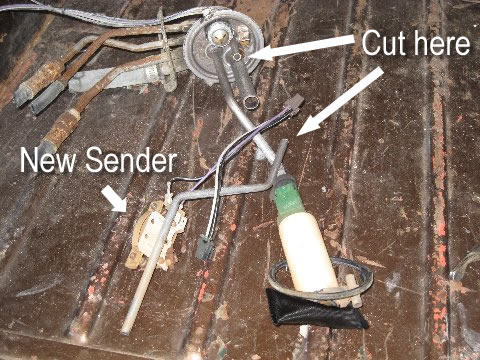
Here is the unit assembled. The new plug had a hole in the center so I could run the new gas line through it. Also, the plug had a hole for the wires as well. I drilled three holes around the radius of the sending unit base and welded the plug in place. You can see the welds in the image below.

Note the J-B Weld. There is about 1/8″-3/16″ between the top of the plug and top of the unit. I used J-B Weld to pot and seal the unit. J-B weld (http://www.jbweld.net/products/jbweld.php) claims to be resistant to gas (from the website: “It’s strong as steel and impervious to water, gasoline, chemicals, and acids.”). DO NOT USE SILICONE!!!
[Editor’s note: Mitch mentioned months ago that he had a problem using J-B Weld to seal an old gas tank. Given the claims by J-B, maybe Mitch’s problem was more an adherence to the old tank rather than J-B itself? Any thoughts Mitch? This should be a good test of J-B and gasoline. ]
Now, I had to adjust the float to work correctly with the new unit. I cut the arm at the first bend from the float then turned it 90 degrees. I also cut the float down an inch.
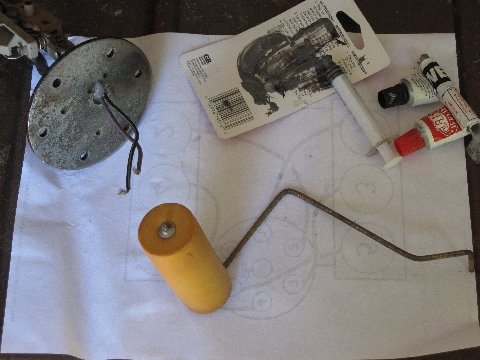
Note: there is a pattern to the bolt circle on the old unit. Index the sending unit on assembly so the float will clear the internal wall in the tank. The wall runs across side-to-side; the float will have to do the same.
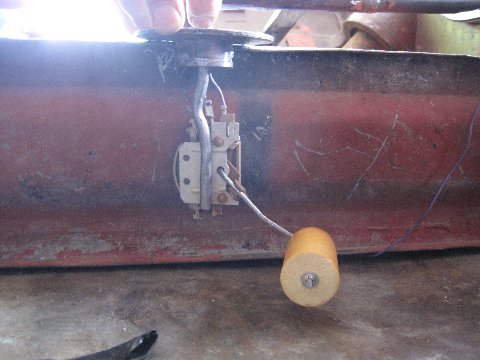
Adjusting the float was easy. I just held it to the top of the tank and bent the arm as needed.
One good thing about this modern sending unit is the rheostat can be replaced by removing two screws. You would have to get another one from a junk yard but can easily be rebuilt.
This works really well … I love these types of projects.
Brian
It doesn’t look in good condition. No additional information on the condition.
“Will trade for 4 wheel drive. Big enough to pull 4 horse trailer.”
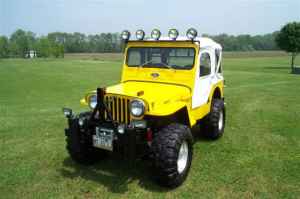 I’d like to see some more pics of this jeep. It looks good in this pic and sounds like there have been some interesting mods.
I’d like to see some more pics of this jeep. It looks good in this pic and sounds like there have been some interesting mods.
“Work Accomplished and Modifications ENGINE: 302 Ford Bored .040 over, balanced, Competition Cam with Roller Rockers. (rebuilt by Engine Performance – April 02). CLUTCH: 11” Hydraulic. TRANSMISSION: T-18, 4 Speeds with Granny Low. TRANSFER CASE: Spicer Model 18 gears in a 20 Case. (rebuilt April 02)
OVERDRIVE: Warn. FRONT DIFFERENTIAL: Dana 44 Scout w/ARB locker and 538 Gears. REAR DIFFERENTIAL: Dana 44 w/ARB Locker and 538 Gears. ELECTRICAL: Wiring Harness Designed by Owner. Relays switching ground Operate Accessories. FUEL SYSTEM: Dual Tanks, Each Having an Electric Pump Backup
BRAKES: Power 4 Wheel Disc, Chevett Booster w/ Corvette Master Cylinder STEERING: GM Power Steering Box with GM Pump. HEATERS: Two, One Under Dash and One Under Seat, Designed and Fabricated By Owner. DEFROSTER SYSTEM: Designed Using Gas Furnace Burners. BODY: Original, Dipped and Repaired With New Metal and Sandwiched with Rhino Lining. PAINT: PPG Deltron Base Coat Clear Coat
This Willys was purchased from Craig Colorado in 1980 and had a complete restoration at that time. The 302 was installed ahead of the original T-90 Transmission, a Warn Overdrive was added and the remaining drive train was original. In 1996 another restoration was completed to include the items listed above. The restorations, fabrications and modifications were accomplished by the owners.”